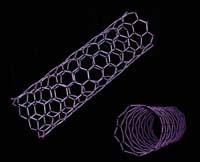Hydrogen in carbon flowers

Hydrogen can be a good substitute for fossil fuels, according to many experts. On the one hand, it is a renewable energy source and on the other, it does not emit greenhouse gases. On the contrary, water vapor is the only gas emitted when using hydrogen as an energy source. Therefore, considering that the two main problems of fossil fuels are their exhaustion and the pollution they cause, hydrogen seems a good option before them.
Although hydrogen has a lower energy density than petroleum derivatives, this density is sufficient to, for example, circulate several passenger transport vehicles. Not a new issue, the first hydrogen powered vehicle prototype (GM Electrovan) was developed in 1966 by US firm General Motors. And today, many automotive households are developing vehicles that move thanks to hydrogen fueled fuel cells.
However, there are still barriers to the use of hydrogen as a source of energy. And one of the main ones is to find an efficient, cheap and safe means of collecting hydrogen. To be effective as a source of energy it is necessary to store hydrogen in a relatively high density. Thus, it can be stored as a compressed or liquefied gas, but in many cases its use is limited by the cost of building safe containers for the collection of compressed gas or the management of cryogenic liquid --liquefied hydrogen -.
Another option is adsorption. That is, instead of collecting hydrogen in the gas or liquid state mentioned, it is stored glued in an adsorbent. In recent years many researchers are working to find suitable adsorbents. In these adsorbents, hydrogen should adhere to a relatively high density, but not chemically react with the adsorbent.
Some metals can perform this function, but they are very expensive. On the contrary, porous materials, in addition to being cheaper, are more efficient, since all the adsorbed hydrogen can be recovered and once the hydrogen is collected and detached, it is not necessary to regenerate or reactivate it.

Among porous materials, researchers sought carbon nanostructures for their small mass and high adsorption capacity. However, numerous studies have shown that in the case of carbon nanotubes the interaction between hydrogen and carbon is very weak, and that if carbon based porous materials are used for hydrogen uptake, this interaction should be more intense.
Well, according to a study by an international group of researchers, the carbon-hydrogen interaction in another carbon nanostructure may be powerful enough to be used as an adsorbent. The study, coordinated by Javier Bermejo, member of the CSIC (Consejo Superior de Investigaciones Cientificas) and research professor attached to the UPV, has shown that carbon nanoramas are effective in collecting hydrogen. The study has been published in one of the most important magazines in the field of physics: Physical Review Letters.
Carbon Alias
Carbon nanoramas were first seen in 1999. They are structures similar to nanotubes, but they close at one end and acquire a conical shape similar to a branch. Nanoramas are monolayer, that is, they have the wall of the thickness of a carbon atom. Each branch is 2-3 nm, but they are grouped into groups forming aggregates in the form of dahlias between 80 and 100 nm in diameter, formed by hundreds of branches. These flowers are characterized by their great adsorption capacity. In fact, they have a huge specific surface, 400 m 2 in a single gram. In this way, they can store large amounts of hydrogen in a small place.
In addition, compared to nanotubes, the manufacture of nanoramas is relatively simple. Laser vaporization of carbon at room temperature allows to obtain flowers of high purity nanoramas, with a yield of 90%.

Specifically, the study analyzes the mobility of adsorbed gas at different temperatures and the details of the interaction between hydrogen and nanoramas.
The most outstanding result has been that hydrogen adheres to nanoramas with a solidity different from other nanostructures, and that however, when desired to use, it can be released under controlled conditions. Thus, researchers believe that carbon nanoramas can be a material of great future as a light hydrogen storage medium.





